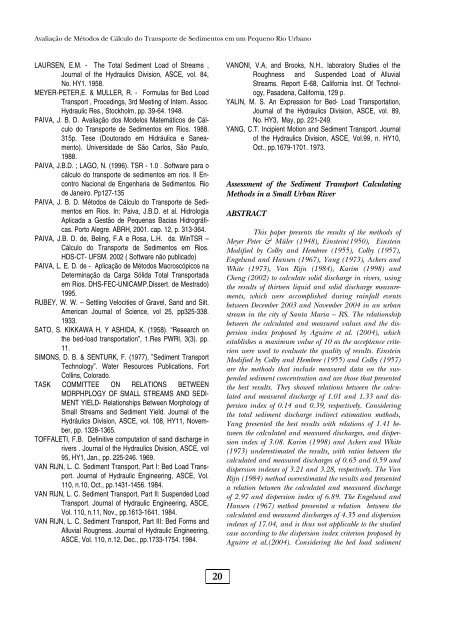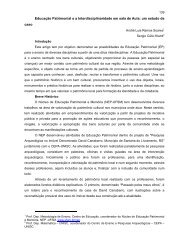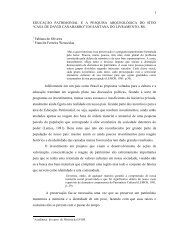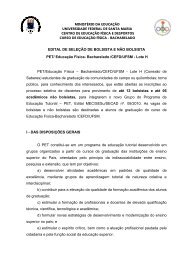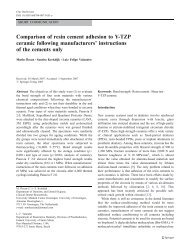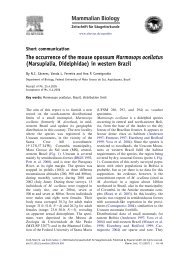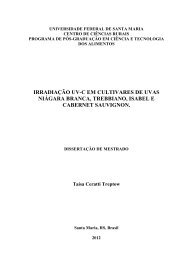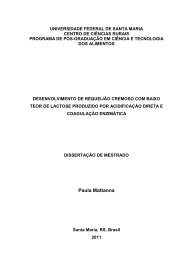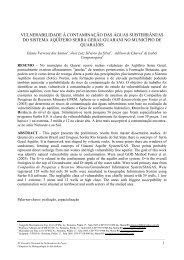Visualizar na Íntegra - Associação Brasileira de Recursos Hídricos
Visualizar na Íntegra - Associação Brasileira de Recursos Hídricos
Visualizar na Íntegra - Associação Brasileira de Recursos Hídricos
You also want an ePaper? Increase the reach of your titles
YUMPU automatically turns print PDFs into web optimized ePapers that Google loves.
Avaliação <strong>de</strong> Métodos <strong>de</strong> Cálculo do Transporte <strong>de</strong> Sedimentos em um Pequeno Rio Urbano<br />
LAURSEN, E.M. - The Total Sediment Load of Streams ,<br />
Jour<strong>na</strong>l of the Hydraulics Division, ASCE, vol. 84,<br />
No. HY1. 1958.<br />
MEYER-PETER,E. & MULLER, R. - Formulas for Bed Load<br />
Transport , Procedings, 3rd Meeting of Intern. Assoc.<br />
Hydraulic Res., Stockholm, pp. 39-64. 1948.<br />
PAIVA, J. B. D. Avaliação dos Mo<strong>de</strong>los Matemáticos <strong>de</strong> Cálculo<br />
do Transporte <strong>de</strong> Sedimentos em Rios. 1988.<br />
315p. Tese (Doutorado em Hidráulica e Saneamento).<br />
Universida<strong>de</strong> <strong>de</strong> São Carlos, São Paulo,<br />
1988.<br />
PAIVA, J.B.D. ; LAGO, N. (1996). TSR - 1.0 . Software para o<br />
cálculo do transporte <strong>de</strong> sedimentos em rios. II Encontro<br />
Nacio<strong>na</strong>l <strong>de</strong> Engenharia <strong>de</strong> Sedimentos. Rio<br />
<strong>de</strong> Janeiro. Pp127-135<br />
PAIVA, J. B. D. Métodos <strong>de</strong> Cálculo do Transporte <strong>de</strong> Sedimentos<br />
em Rios. In: Paiva, J.B.D. et al. Hidrologia<br />
Aplicada a Gestão <strong>de</strong> Peque<strong>na</strong>s Bacias Hidrográficas.<br />
Porto Alegre. ABRH, 2001. cap. 12, p. 313-364.<br />
PAIVA, J.B. D. <strong>de</strong>, Beling, F.A e Rosa, L.H. da. WinTSR –<br />
Cálculo do Transporte <strong>de</strong> Sedimentos em Rios.<br />
HDS-CT- UFSM. 2002 ( Software não publicado)<br />
PAIVA, L. E. D. <strong>de</strong> - Aplicação <strong>de</strong> Métodos Macroscópicos <strong>na</strong><br />
Determi<strong>na</strong>ção da Carga Sólida Total Transportada<br />
em Rios. DHS-FEC-UNICAMP.Dissert. <strong>de</strong> Mestrado)<br />
1995.<br />
RUBEY, W. W. – Settling Velocities of Gravel, Sand and Silt.<br />
American Jour<strong>na</strong>l of Science, vol 25, pp325-338.<br />
1933.<br />
SATO, S. KIKKAWA H, Y ASHIDA, K. (1958). “Research on<br />
the bed-load transportation”, 1.Res PWRI, 3(3). pp.<br />
11.<br />
SIMONS, D. B. & SENTURK, F. (1977), ”Sediment Transport<br />
Technology”. Water Resources Publications, Fort<br />
Collins, Colorado.<br />
TASK COMMITTEE ON RELATIONS BETWEEN<br />
MORPHPLOGY OF SMALL STREAMS AND SEDI-<br />
MENT YIELD- Relationships Between Morphology of<br />
Small Streams and Sediment Yield. Jour<strong>na</strong>l of the<br />
Hydráulics Division, ASCE, vol. 108, HY11, November,<br />
pp. 1328-1365.<br />
TOFFALETI, F.B. Definitive computation of sand discharge in<br />
rivers . Jour<strong>na</strong>l of the Hydraulics Division, ASCE, vol<br />
95, HY1, Jan., pp. 225-246. 1969.<br />
VAN RIJN, L. C. Sediment Transport, Part I: Bed Load Transport.<br />
Jour<strong>na</strong>l of Hydraulic Engineering, ASCE, Vol.<br />
110, n.10, Oct., pp.1431-1456. 1984.<br />
VAN RIJN, L. C. Sediment Transport, Part II: Suspen<strong>de</strong>d Load<br />
Transport. Jour<strong>na</strong>l of Hydraulic Engineering, ASCE,<br />
Vol. 110, n.11, Nov., pp.1613-1641. 1984.<br />
VAN RIJN, L. C. Sediment Transport, Part III: Bed Forms and<br />
Alluvial Rougness. Jour<strong>na</strong>l of Hydraulic Engineering,<br />
ASCE, Vol. 110, n.12, Dec., pp.1733-1754. 1984.<br />
20<br />
VANONI, V.A, and Brooks, N.H.. laboratory Studies of the<br />
Roughness and Suspen<strong>de</strong>d Load of Alluvial<br />
Streams. Report E-68, California Inst. Of Technology,<br />
Pasa<strong>de</strong><strong>na</strong>, California, 129 p.<br />
YALIN, M. S. An Expression for Bed- Load Transportation,<br />
Jour<strong>na</strong>l of the Hydraulics Division, ASCE, vol. 89,<br />
No. HY3, May, pp. 221-249.<br />
YANG, C.T. Incipient Motion and Sediment Transport. Jour<strong>na</strong>l<br />
of the Hydraulics Division, ASCE, Vol.99, n. HY10,<br />
Oct., pp.1679-1701. 1973.<br />
Assessment of the Sediment Transport Calculating<br />
Methods in a Small Urban River<br />
ABSTRACT<br />
This paper presents the results of the methods of<br />
Meyer Peter & Müler (1948), Einstein(1950), Einstein<br />
Modified by Colby and Hembree (1955), Colby (1957),<br />
Engelund and Hansen (1967), Yang (1973), Ackers and<br />
White (1973), Van Rijn (1984), Karim (1998) and<br />
Cheng (2002) to calculate solid discharge in rivers, using<br />
the results of thirteen liquid and solid discharge measurements,<br />
which were accomplished during rainfall events<br />
between December 2003 and November 2004 in an urban<br />
stream in the city of Santa Maria — RS. The relationship<br />
between the calculated and measured values and the dispersion<br />
in<strong>de</strong>x proposed by Aguirre et al. (2004), which<br />
establishes a maximum value of 10 as the acceptance criterion<br />
were used to evaluate the quality of results. Einstein<br />
Modified by Colby and Hembree (1955) and Colby (1957)<br />
are the methods that inclu<strong>de</strong> measured data on the suspen<strong>de</strong>d<br />
sediment concentration and are those that presented<br />
the best results. They showed relations between the calculated<br />
and measured discharge of 1.01 and 1.33 and dispersion<br />
in<strong>de</strong>x of 0.14 and 0.39, respectively. Consi<strong>de</strong>ring<br />
the total sediment discharge indirect estimation methods,<br />
Yang presented the best results with relations of 1.41 between<br />
the calculated and measured discharges, and dispersion<br />
in<strong>de</strong>x of 3.08. Karim (1998) and Ackers and White<br />
(1973) un<strong>de</strong>restimated the results, with ratios between the<br />
calculated and measured discharges of 0.65 and 0.59 and<br />
dispersion in<strong>de</strong>xes of 3.21 and 3.28, respectively. The Van<br />
Rijn (1984) method overestimated the results and presented<br />
a relation between the calculated and measured discharge<br />
of 2.97 and dispersion in<strong>de</strong>x of 6.89. The Engelund and<br />
Hansen (1967) method presented a relation between the<br />
calculated and measured discharges of 4.35 and dispersion<br />
in<strong>de</strong>xes of 17.04, and is thus not applicable to the studied<br />
case according to the dispersion in<strong>de</strong>x criterion proposed by<br />
Aguirre et al.(2004). Consi<strong>de</strong>ring the bed load sediment


